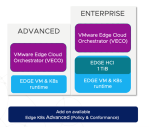 By 2024, there will be a forecasted 1.5 billion 5G mobile subscriptions worldwide. Currently, 5G is at a transition point that will soon mark the arrival and evolution of new trends in the telco market.
By 2024, there will be a forecasted 1.5 billion 5G mobile subscriptions worldwide. Currently, 5G is at a transition point that will soon mark the arrival and evolution of new trends in the telco market.
Much like 3G and 4G allowed for innovations and the growth of services over the air such as multimedia and social media, 5G is expected to bring about significant market changes. Unfortunately, today’s infrastructure isn’t suited for the demands of the 5G networks of tomorrow and will crumble under the service workload.
AT&T is one telco that understands the need for a new level of network control. The company recently announced it is working with VMware SD-WAN by VeloCloud to provide greater network control and flexibility for businesses moving to 5G.
This represents the first time SD-WAN and 5G are implemented together. For any communications service providers (CSPs) or telecommunications companies preparing for 5G, having the right strategy and technology to define and maintain their architecture is key to success.
Potential Challenges with 5G
5G represents the best opportunity for the telco industry and CSPs in years. With AT&T already introducing the first mobile 5G network in the U.S., the demand for 5G networks is already here.
Unfortunately, many CSPs still rely on a rigid, hardware-based architecture that can’t keep up with the speed and agility 5G requires. Telco companies need faster networks and the ability to rapidly adapt to changing demands and new opportunities.
- Demand for Speed and Agility: 5G will create a boom of new services and technologies. CSPs will need to build and launch these new services quickly to meet the needs of their customers.
- Need to Keep Costs Down: Spending on 5G network infrastructure is expected to explode from $528 million in 2018 to $26 billion in 2022. As CSPs face their biggest expenditure in decades, keeping costs down and making immediate profits will be a top priority.
- Heavy Opportunity Cost for Delays: At the speed 5G adoption is taking, CSPs can’t afford any service delays or issues deploying their new infrastructure. Any delays will result in significant loss of revenue and market share.
In order to rapidly and efficiently respond to the demands of a 5G network, CSPs need a software-driven ‘telco cloud’ architecture that allows them to develop and deploy services while still optimizing usage and costs.
AT&T recognized the transformative power of SD-WAN and 5G were limited by separating the technologies. Before the integration, its SD-WAN merely served as the point of intelligence for application-aware networking that did not lend any benefits to their 5G demands. By extending SD-WAN to support 5G networks, traffic can now be automatically prioritized by device or application to improve agility and reduce costs.
How SD-WAN Supports 5G
Roman Pacewicz, chief product officer of AT&T Business, explained the benefits of combining SD-WAN and 5G in a recent press release:
“Better intelligence means better outcomes for businesses. SD-WAN and 5G individually have the power to significantly transform a business. But when you put them both together, you open the door to insight on an entirely different level. With that comes new capabilities and opportunities that can help businesses innovate faster in the next phase of their transformation.”
Faced with the challenges of deploying and managing a 5G network, SD-WAN enables telcos to leverage software-defined data centers and wide area networking to increase agility, reduce hardware spend and optimize their existing infrastructure to keep costs down.
Here are some of the benefits AT&T is seeing through the combination of 5G and SD-WAN:
- Increased Agility: SD-WAN allows a 5G network to develop automated networks from core to edge to enable a number of devices and services to operate simultaneously on the network. With the ability to deploy networks to the telco cloud, companies can respond more rapidly to changing demands.
- Lower Costs: With unprecedented visibility and automation, CSPs can capture efficiencies in existing hardware to keep costs as low as possible.
- Virtual Cloud Networking: The move to 5G will result in outdated networking topologies that need to be transformed immediately. Virtual cloud networking can quickly establish an interconnected network of environments to drive 5G success and enable the future growth of new 5G telco services.
In addition to AT&T, VMware is working with a number of leading CSPs to bring SD-WAN into 5G networks. The ability to deploy networks to the telco cloud while simplifying branch networking and infrastructure is key to 5G architectures that are agile, optimized and cost-effective.
AT&T’s adoption of VMware SD-WAN by VeloCloud marks the beginning of businesses of all sizes better positioning their network intelligence to capture the advantages of 5G. As new opportunities arise for the telco market, the companies that see the most success will be the ones with an intelligent, automated network that can adapt to the demands 5G will bring.






